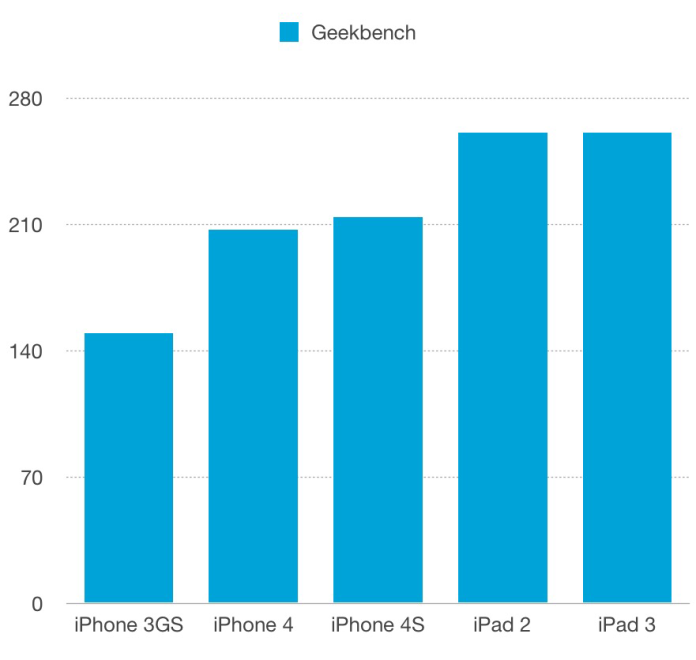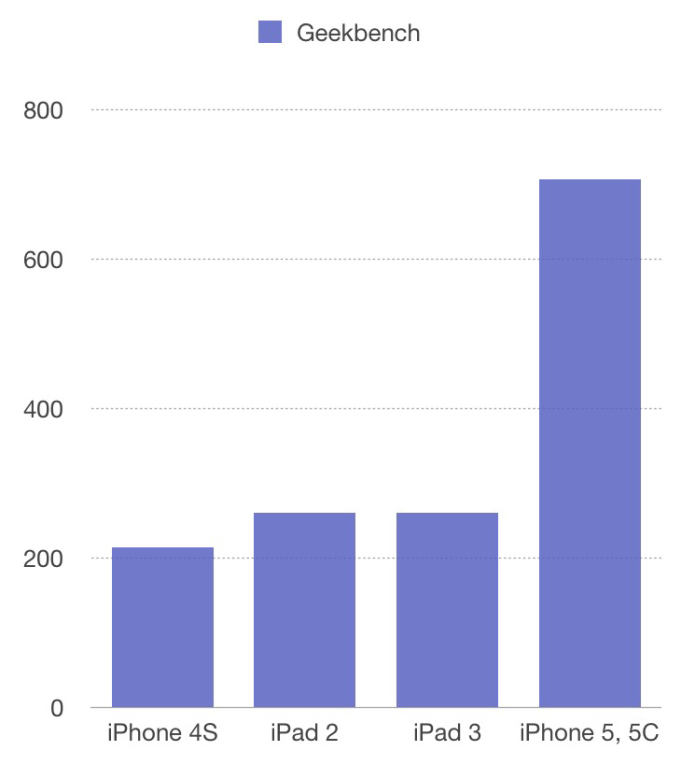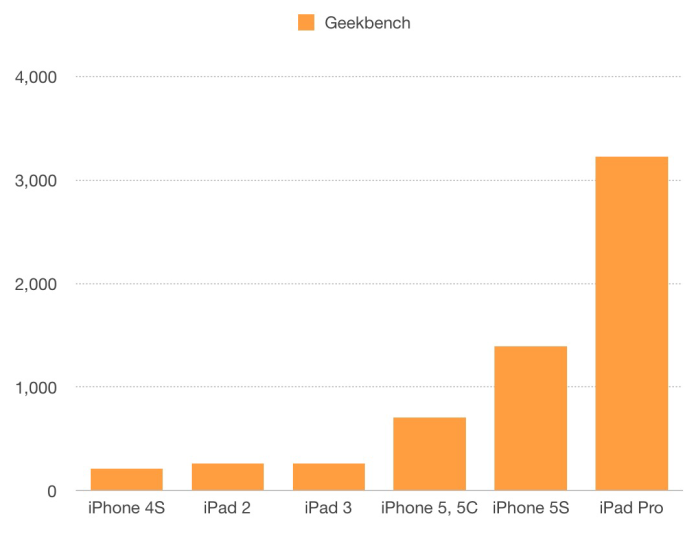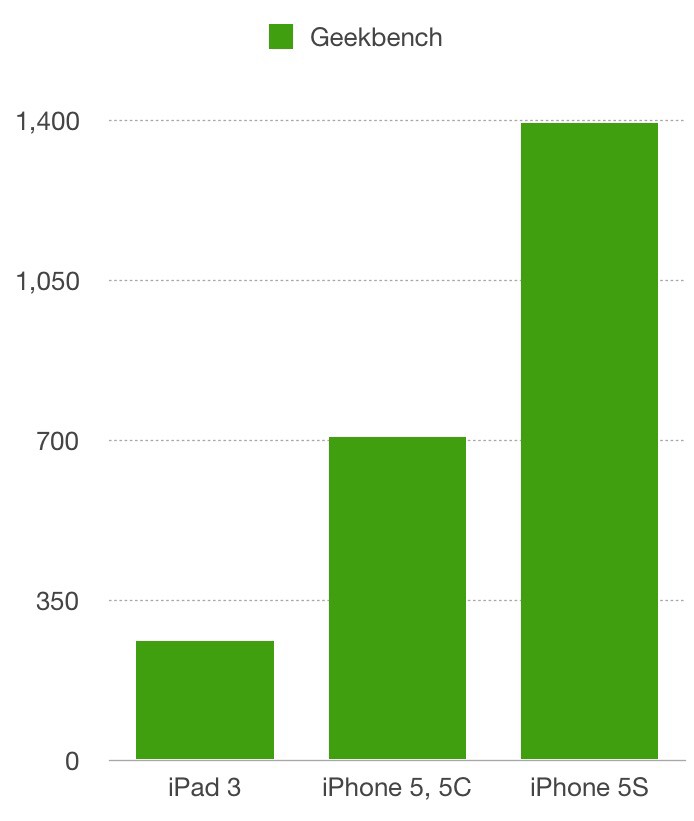The almost-universal sentiment when the iPad Pro came out was: Hardware Good, Software Bad.
I wrote about this again recently, saying that the debut of iPad Pro was the opposite of the original iPhone: Where the original iPhone had great software, it was kneecapped by slow hardware; on the other hand the iPad Pro has PC-speed hardware, but the software (apps and, to some extent, iOS) were met with a giant collective shrug.
So, why would Apple release a great new hardware product like iPad Pro (even the iPhone 6s is super speedy and could use a better Mail and Photo apps) and let us down in terms of software?
What I think is happening is this:
Apps can only be as powerful as the operating system they’re running on, and iOS 9 is limited by its support for very old devices with very slow CPUs. Let me show you a few graphs to illustrate what I mean.

The graph above shows the relative performance (using Geekbench 3)* of some of Apple’s early iOS devices. You can see that they generally get faster every year, sometimes by as much as 33% faster. This is nice, but not earth shattering. As each version of iOS gets a little more powerful, older hardware is no longer supported.
The key here is that iOS can only get as powerful as the slowest hardware that it supports.
Think about that for a second. As powerful as an iPhone 6s or iPad Pro is, iOS 9 still has to support iPhone 4S and iPad 2 devices. So Apple couldn’t make iOS 9 and apps like Mail and Photos super powerful on the iPad Pro, because they’d be dog slow—or not work at all—on these older devices.
So the question becomes: What devices will iOS 10 drop support for, and what is the performance difference between the devices in the graph above and the new slowest device that iOS 10 supports. Well, the logical option is for Apple to drop all the devices above, and support only the iPhone 5 and iPad 4 and above (A6/A6X processors). So how big is the performance jump from the A5 (iPhone 4S, iPad 2&3) to the A6?

This graph shows the incredible performance increase from the A5 to the A6: we’re not talking a 10% or 25% or even 33% faster CPU, we’re talking about a CPU that’s 2.5x faster!
Since iOS 10 will almost surely drop support for these older devices, it can now be prodded to do a lot of things that iOS could never do before. Things like allowing Mail to tag junk mail. Things like showing Smart Albums in Photos. Things like making the Photos app more like iPhoto or Aperture on a Mac. Wouldn’t it be great if you could use an Apple Pencil to mask images in the Photos app to apply changes just to select portions of a photo? Wouldn’t it be great if you could script Photos or Mail to do things using snippets of Swift or JavaScript code? Wouldn’t it be great to automate apps, the way desktop OSes can? Wouldn’t it be great if Siri were faster and maybe did more on-device, rather than always having to go to the Internet?
I’m not promising any of these things, but these are just some of the possibilities that you can envision once the shackles of old hardware are removed from iOS.
And if you think the A6 was a big improvement in the graph above (from a Geekbench of 250 to over 700!), check out where we are today:

That’s right, at a Geekbench score of over 3,200, the iPad Pro is over 10x as fast as the iPad 3.
We are entering the golden age of mobile computers, which means software will start peaking at what it can do. (It also means we are on the cusp of when wearable devices like Apple Watch start their inevitable climb to mostly replace mobile devices.) Soon there will be no limitations as to what your device can do.
So, as exciting as iOS 10 will be, let me leave you with an additional thought about the next version of iOS, iOS 11:
This graph tells you about the possibility of further improvements in iOS 11, when, presumably, the iPhone 5 & 5C (A6) will be dropped from support, and the iPhone 5S (A7 CPU) becomes the slowest device that’s supported (that will also mark the beginning of exclusively 64-bit software in the mobile space). The 5S is again 2x as fast as the 5 & 5C, allowing iOS 11 to do much more than even iOS 10 will do.
For now, we can be content that iOS 10 has much more potential to help iPad Pro and even your iPhone 6 or 6s become the killer device that its hardware allows it to.
So prep yourself for WWDC 2016—it’s going to be a doozy.
*—Yes, Geekbench is not the end-all, be-all of device performance. For example, the iPhone 4S seemed much faster than the iPhone 4 even though their Geekbench scores are very similar. Perceived performance is more than just CPU speed: it’s I/O speed, memory, GPU speed, number of GPU cores, etc. I’m just using Geekbench here as a proxy for overall relative speed.

















